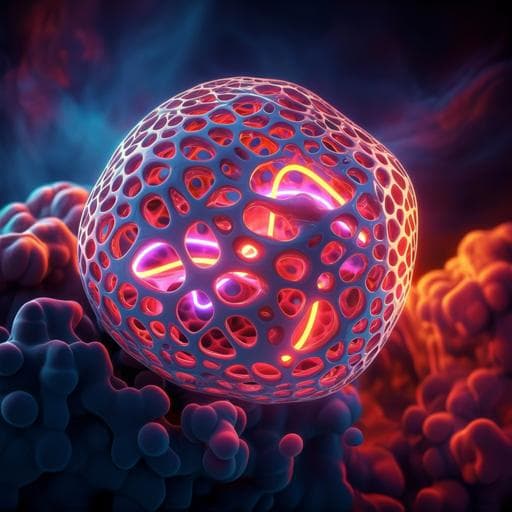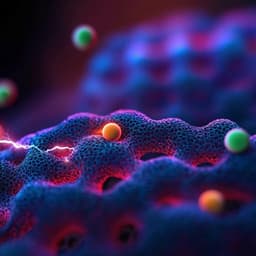
Engineering and Technology
Moisture-resistant, stretchable NOx gas sensors based on laser-induced graphene for environmental monitoring and breath analysis
L. Yang, G. Zheng, et al.
This research led by Li Yang and colleagues unveils a groundbreaking moisture-resistant and stretchable NOx gas sensor made from laser-induced graphene. Engineered for high sensitivity to NO and NO2, this innovative sensor allows for 30% stretching, making it ideal for environmental monitoring and respiratory disease analysis. Experience the future of gas sensing technology!
~3 min • Beginner • English
Introduction
Wearable electronic devices can capture mechanical, thermal, chemical, electrical, and biological signals for health monitoring. There is growing interest in wearable gas sensors for personal air quality monitoring and breath analysis, particularly for nitrogen oxides (NOx), which are major atmospheric pollutants linked to respiratory and cardiovascular issues. Nitric oxide (NO) in exhaled breath is an important biomarker of airway inflammation; elevated ppb-level NO is associated with diseases such as asthma, COPD, lung cancer, and ventilator-associated pneumonia. Prior NOx sensing materials include graphene, metal oxides, conducting polymers, and carbon nanotubes. Graphene-based chemiresistive sensors are attractive for wearable applications due to simple fabrication, low noise, and mechanical robustness, but pristine graphene typically suffers from low sensitivity and poor selectivity. Laser-induced graphene (LIG), a highly porous 3D graphene formed by laser scribing polyimide, offers abundant active sites and low contact resistance, and has shown promise for NO2 detection, hybrid junction enhancement, and thermal conductivity-based sensing of other gases. A key challenge is humidity: water molecules can occupy active sites and disrupt adsorption equilibria, particularly in high-RH breath (50–95%). Existing mitigation strategies (hydrophobic SAMs, moisture barriers, integrated heaters, e-nose algorithms) often add complexity and cost. The study aims to develop a facile, moisture-resistant, stretchable LIG-based NOx sensor with high sensitivity, fast kinetics, low LOD, selectivity, and robustness for environmental monitoring and breath analysis.
Literature Review
The paper reviews prior approaches to NOx detection using graphene, metal oxides, conducting polymers, and carbon nanotubes. It highlights the advantages of graphene-based chemiresistive sensors for wearables (simple fabrication, low noise, mechanical strength) but notes their typical limitations in sensitivity and selectivity due to limited active sites and non-selective adsorption. LIG is introduced as a porous 3D graphene produced via rapid, low-cost CO2 laser scribing on polyimide, offering high surface area and low contact resistance. Previous LIG-based sensors have targeted NO2 (including hybrid P–N junctions to enhance carrier mobility) and other gases via thermal conductivity changes. The humidity challenge in gas sensing is emphasized: water occupation of active sites affects adsorption/desorption equilibria, causing response fluctuations, especially in high-RH breath. Mitigation strategies such as hydrophobic SAM coatings, moisture barrier layers, integrated heating, and algorithmic compensation are cited, but these increase complexity and cost, motivating a simpler moisture-resistant design.
Methodology
Device design and fabrication: The sensor consists of a straight LIG sensing region and serpentine Ag/LIG electrodes on a soft elastomeric Ecoflex substrate (500 µm thick). The sensing region width is 150 µm to yield higher resistance and localized Joule heating; electrodes are 0.5 mm wide to minimize resistance. A thin semipermeable polydimethylsiloxane (PDMS) membrane (~10 µm) encapsulates the device to impart moisture resistance while allowing gas permeability. A stiff polyimide (PI) island under the sensing region provides strain isolation; the serpentine electrode geometry ensures stretchability.
Fabrication process (scalable and low-cost): Commercial PI film adhered to a glass slide is laser scribed using a CO2 laser in ambient conditions to form patterned 3D porous LIG. Raster mode is used for electrodes and vector mode for the sensing region. The patterned LIG is transferred to Ecoflex. The serpentine electrode region is coated with silver ink to further reduce resistance. A thin PDMS film is spin-coated to encapsulate the device, yielding a moisture-resistant, stretchable sensor suitable for on-skin placement below the nose.
Laser parameter optimization and materials characterization: Key laser parameters—power, image density (PPI), and defocus distance—were varied to tune LIG morphology, defect level, and surface area. SEM assessed morphology: increasing power from 0.15 W to 0.6 W transitions from sheet-like to needle-like structures; higher powers (1.2–1.8 W) yield closed rose-petal and collapsed hole-like microstructures. Increasing image density from 500 to 1000 PPI at 0.6 W overheats and degrades the needle-like structure. Defocus distance increase (0–9 mm) increases defects. Raman spectroscopy identified D, G, 2D peaks; ID/IG and I2D/IG ratios and G peak FWHM quantified graphitization quality, with needle-like LIG (0.6 W, 500 PPI, 0 mm defocus) showing highest quality (lowest ID/IG, narrowest G FWHM). XPS survey of optimally processed LIG shows C and O, with C1s deconvolution into C–C (284.5 eV), C–O (285.2 eV), and C=O (288.7 eV). BET measurements quantified specific surface area versus processing conditions (up to 296 m2/g for needle-like LIG).
Electrical/sensing characterization: The chemiresistive p-type LIG sensor response is defined as ΔR/R0 = (R − R0)/R0, where R0 is baseline resistance in air and R is resistance in target gas. Tests conducted at room temperature (25 °C) with a bias of 0.05 V unless noted. Responses to oxidizing NOx (electron acceptors) cause resistance decreases. Continuous dynamic tests were conducted across NO concentrations from 0.5 to 2.5 ppm to assess response/recovery behavior. Repeatability (multi-cycle exposures), long-term stability (over 15 days), and effect of operating temperature (self-heating via applied voltage up to 15 V raising sensor to ~65 °C) were evaluated. Joule heating impact on baseline resistance and input power was recorded. Stretchability was achieved via serpentine electrodes and strain isolation, allowing up to 30% strain. Moisture resistance was evaluated up to 90% RH. The device was demonstrated for on-body environmental monitoring and breath sampling near the nose.
Key Findings
- Optimal LIG morphology and processing: Needle-like LIG produced at 0.6 W laser power, 500 PPI image density, and 0 mm defocus exhibited highest graphitization quality (lowest ID/IG), narrowest G peak FWHM, and largest BET surface area (296 m2/g). Higher powers or PPIs increased defects and decreased surface area (e.g., 1000 PPI reduced surface area to 129 m2/g).
- Sensitivity and response: Using needle-like LIG, the sensor achieved sensitivities of 4.18% ppm−1 to NO and 6.66% ppm−1 to NO2. At 1 ppm NO, responses varied with laser parameters: 0.15 W (2.60%), 0.6 W (4.0%), 1.2 W (3.10%), 1.8 W (2.20%). Increasing PPI from 500 to 1000 decreased response from 4.0% to 1.7%; increasing defocus from 0 to 9 mm decreased response from 4.1% to 0.9%.
- Detection limits: Ultralow LODs of 8.3 ppb (NO) and 4.0 ppb (NO2) at room temperature.
- Kinetics: Fast response/recovery at room temperature: for NO, 113/296 s (1 ppm); dynamic response increased from 2.6% at 0.5 ppm to 5.5% at 2.5 ppm. For NO2, response/recovery 134/388 s reported in abstract.
- Stability and repeatability: Stable response of ~4.0% to 1 ppm NO with response/recovery 110/330 s over eight consecutive cycles; response remained nearly unchanged over 15 days.
- Temperature effects and self-heating: Elevating operating temperature from 25 °C to 60 °C reduced recovery time from ~400 s to ~210 s. Self-heating via applied voltage up to 15 V raised sensor temperature to ~65 °C; baseline resistance decreased modestly by 3.1% with negligible impact on input power.
- Mechanical and environmental robustness: Stretchable up to 30% strain with mechanical stability during stretching, twisting, and coiling. Moisture-resistant operation maintained up to 90% RH.
- Application demonstrations: On-skin placement below the nose enabled monitoring of personal local environment at different times of day and analysis of clinical breath samples, enabling classification of patients with respiratory diseases versus healthy volunteers.
Discussion
The study addresses the challenge of developing a low-cost, wearable NOx sensor that maintains high sensitivity and stability under high humidity and mechanical deformation. By engineering the LIG morphology via laser parameter optimization, the sensor achieves high specific surface area and low defect density, enhancing adsorption-driven chemiresistive responses to oxidizing NOx. Encapsulation with a thin semipermeable PDMS membrane provides moisture resistance without significant complexity, preserving sensor performance at up to 90% RH, which is crucial for breath analysis. The device demonstrates fast response and recovery at room temperature, ultralow detection limits in the single-digit ppb range, and good selectivity (as stated), meeting requirements for detecting exhaled NO and environmental NOx. The serpentine electrode design and strain isolation ensure mechanical durability and stable performance under 30% strain, enabling comfortable on-skin wear. Self-heating offers a practical means to accelerate desorption and improve recovery, with minimal impact on baseline resistance and manageable thermal considerations. Demonstrations in real-world scenarios—ambient monitoring and clinical breath analysis—underscore the sensor’s relevance for personal exposure tracking and noninvasive respiratory disease screening.
Conclusion
This work presents a moisture-resistant, stretchable NOx gas sensor based on optimally engineered laser-induced graphene, encapsulated with a thin semipermeable PDMS membrane and integrated on a soft elastomeric substrate. By tuning laser power, image density, and defocus distance, a needle-like LIG morphology with high surface area (296 m2/g) and low defects was achieved, enabling high sensitivity (4.18% ppm−1 to NO; 6.66% ppm−1 to NO2), ultralow LODs (8.3 ppb NO; 4.0 ppb NO2), fast response/recovery, repeatability, long-term stability, and robustness to high humidity (90% RH) and mechanical strain (30%). The sensor was successfully used for on-body local environmental monitoring and breath analysis to distinguish patients with respiratory diseases from healthy subjects. Future work could further optimize humidity shielding and thermal management for on-skin comfort, extend long-term stability assessments, and expand multi-gas selectivity profiling for comprehensive breathomics and environmental monitoring.
Limitations
- Incomplete recovery at room temperature during dynamic cycling is noted, attributed to short recovery times and residual charge carriers; elevated temperatures (via self-heating) improve desorption and recovery but introduce thermal management needs for on-skin use.
- Operating the sensor at ~60–65 °C to accelerate recovery is higher than desired for direct skin contact, necessitating heat sinks or thermal isolation to avoid skin discomfort.
- Long-term stability was demonstrated over 15 days; longer-duration performance and drift under continuous real-world use were not reported.
- Detailed selectivity data against common interferents are not presented in the provided text, though selectivity is claimed.
- Specific affiliations and broader clinical validation details (sample size, patient cohorts) are not provided in the excerpt.
Related Publications
Explore these studies to deepen your understanding of the subject.







